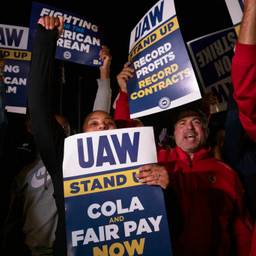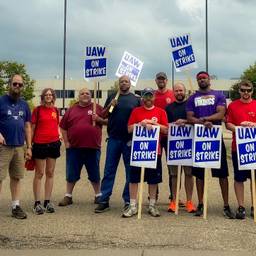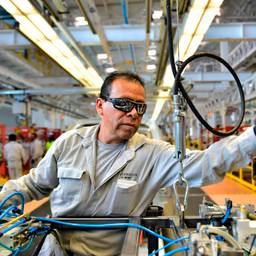Can a National Strike Save a Closed Plant? A Town Depends On It.
The UAW is calling up locals to stand by Stellantis workers in Belvidere, Ill., who were promised a reopening.
Sarah Lazare
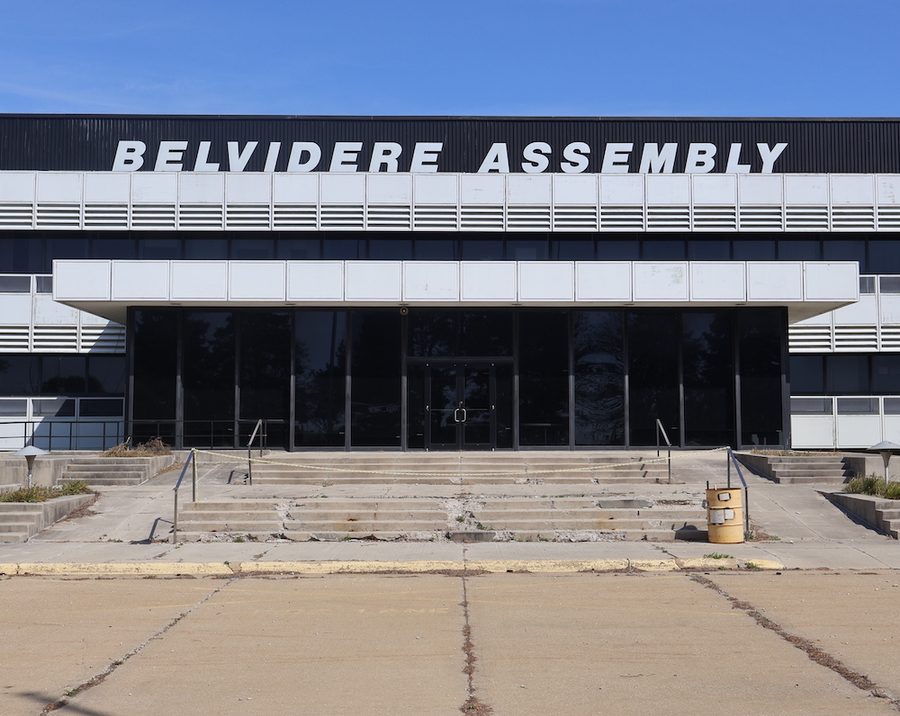
Dawn Simms has been out of work for a year and a half. The Stellantis auto plant where she, her father and grandfather worked most of their adult years now sits idle, ringed with tall grass and weeds. Almost all of the members of her union, United Auto Workers (UAW) Local 1268, have been laid off, too, and the effects have rippled through the northern Illinois town of Belvidere, where restaurants have closed and business at others has slowed, as the need at food pantries has increased.
It’s a familiar Rust Belt story, with a twist. Sitting in the union hall, a five minute drive from the shuttered plant, Simms does not talk like someone resigned to the loss of her livelihood or her home town’s vibrancy. “We’re here and we’re willing to work,” she says. “We want to work. Why can’t you keep your promise and bring your product?”
She’s referring to a historic promise extracted by the UAW in its fall 2023 strike against Stellantis, Ford and General Motors. Stellantis contractually agreed to reopen the Belvidere plant, which had been idled earlier that year after 58 years in operation, and to pursue new manufacturing in the town.
But now, the union says, the company is dragging its feet and attempting to renege on the reopening. UAW leaders are concerned that the real intent is to delay action beyond the May 1, 2028 expiration of the contract, so that the union has to renegotiate the reopening of the plant. In response, the UAW has launched a coordinated, national campaign to hold the company to its word.
Under the leadership of President Shawn Fain, who came in as a reform challenger, the union is testing a thesis: that workers do not have to be subject to the whims of corporations, shuffled from here to there, separated from family or the towns they love when a CEO says it’s time to close down and relocate. By wielding their greatest weapon — the nationwide strike, or simply the threat thereof — workers can have a say in the manufacturing processes that shape their lives.
The union’s stand-up strike against the ‘Big Three’ automakers last fall forced Stellantis, the maker of Chrysler, Jeep and Fiat, to contractually agree not only to reopen the plant but to invest in expanded operations in Belvidere. The company committed to launching a parts distribution “megahub” at the plant in 2024, resuming mid-size truck production by 2027, and establishing a new electric vehicle battery plant in 2028.
The contract language was a lifeline for the town, which has a population of 25,000. “Belvidere, Illinois goes from loser to winner with idled Stellantis plant reopening,” read one headline, from CBS News Chicago. Simms was at a union meeting last fall when she first heard the news, and she says the mood was ecstatic. “People were crying, cheering,” she says. “I called my dad and said, ‘Dad, they’re reopening the plant.’ He just cried. It’s been in our lives forever.”
It was also an unprecedented win for any union, according to Joshua Murray, an associate professor of sociology at Vanderbilt University and co-author of Wrecked: How the American Automobile Industry Destroyed Its Capacity to Compete. “I can think of examples where a closure was announced and the union successfully fought to change the company’s mind (Cooper Tire Plant in 2012), but never reopen a closed plant,” he explains over email.
When I traveled to Belvidere this January, two months after the contract was ratified, workers said they were cautiously optimistic, but would not believe the reopening until they saw their members go back to work in large numbers. Then time passed, and the union didn’t see meaningful signs that any of the three projects were moving forward according to the established timetable — no refurbishing for a megahub or a new mid-sized vehicle line, no ground broken on a new battery plant. Some workers were sent in to maintain the building and do small-scale parts distribution, but it was nothing near what was specified in the contract, says Local 1268’s president, Matt Frantzen.
And now, their fears have been confirmed. Stellantis said in an August 20 statement that “plans for Belvidere will be delayed.” The company said it “firmly stands by its commitment,” yet it has not publicly offered an alternate timeline. When In These Times and Workday Magazine inquired about a timeline, Jodi Tinson, from corporate communications, wrote over email, “We have nothing further to announce at this time.” UAW says the company has broken its contractual promises to Belvidere (which Stellantis denies).
The company’s CEO, Carlos Tavares, recently saw his total compensation jump 56% to $39.5 million — making Tavares the new highest paid Detroit auto executive. Rubbing salt in the wound, on a visit to the Sterling Heights Assembly Plant just a few weeks before the announcement of the Belvidere delay, Tavares criticized workers for their alleged poor quality.

When I returned to Belvidere this month, every worker I talked with said they are furious that the company’s CEO is getting more money while they are out of a job.
“People are pissed. There’s no other way to put it,” says Local 1268 president Frantzen, sitting in his office at the union hall. “They’re pissed that they thought they got sold a bill of goods that wasn’t true. [They thought] we’d be back to work.”
But that’s where the possibility of another nationwide strike comes in. Belvidere workers have no labor to withhold, but workers at other plants do. In its new contract, the union won the right to strike over plant closures and commitments around products and investments, and now the union is taking steps that would enable it to do just that. According to UAW, 17 locals representing tens of thousands of Stellantis workers across the country have filed grievances, charging that the company’s “failure to honor its commitments” to Belvidere “is a serious concern to all bargaining unit members.” Among them are big facilities like the Toledo Assembly Complex in Ohio and the Sterling Heights Assembly Plant in Michigan, and more are poised to follow. The contract says that once a complaint has gone through the grievance process, the union is allowed to strike over it. The grievances don’t mean a strike is preordained, but they certainly open up the possibility.
Stellantis argued in a public statement that the union can’t legally strike at this time because the company hasn’t broken the contract, since the deal allows for contingency according to “plant performance, changes in market conditions and consumer demand.” In announcing the delay, the company cited “market conditions and our ability to accommodate a wide range of consumer demands.” Asked for further comment for this piece, Stellantis spokesperson Tinson pointed In These Times and Workday Magazine back to the public statement.
But UAW President Shawn Fain is rejecting the company’s claims that market conditions drove the closure. He argued in a video statement that the move is the product of the corporate greed, price gouging and poor business decisions of the CEO, as other companies, like Ford and GM, are weathering the “market conditions” much better. (Stellantis has seen sales steadily fall since 2022 while its competitors’ sales have risen.)
“I find a pathetic irony in the fact that Stellantis is now, for the first time, citing ‘market conditions’ as their reason for attempting to break their promises to Belvidere and auto workers across America,” Fain said at an August 22 rally in the Belvidere union hall.
“It’s always ‘market conditions’ when they have to stiff an auto worker or close a plant. It’s never ‘market conditions’ when they want to raise CEO pay by 56%. Carlos Tavares is telling the American auto worker, ‘Market conditions for thee, but not for me.’”
Murray, the sociology professor, says the company’s decision to close down its Belvidere plant “seems to be driven mostly by a desire to reduce labor costs.” He explains over email, “My take is that Stellantis is not as innovative as companies like Tesla, Toyota, and Volkswagen (and others). Unable to compete through constant innovation, competing through keeping production costs low becomes necessary.”
Asked if Stellantis was cutting costs because of failure to innovate, spokesperson Tinson acknowledged that cost-cutting was a focus and attributed the cuts to a “multitude of factors” affecting the entire industry, including electrification and inflation.
Frantzen responds, “We have pretty much the same cookie cutter contract between the ‘Big Three,’ and Stellantis is the one cutting manpower to the bone.”
It’s exactly because the UAW was worried that Stellantis would attempt to back out of its commitments and delay beyond the current contract’s expiration, that the union says it enshrined the right to strike over plant closures and product and investment commitments.
The union’s strategy depends on the workers at other plants to take action even though their own plant is not on the chopping block right now. During the stand-up strike, laid-off Belvidere workers traveled to plants in Colorado, Ohio and Michigan to walk the picket lines. And now they’re hoping these locals will fight for them.
“We’re just the beginning,” says Simms. “If they’re going to go back on Belvidere, who’s to say they’re not going to go back on everything else they agreed to? It’s inspiring other plants are fighting for us, to know we’re not in this alone. It’s part of being a union, right?”
The union’s leadership is signaling to Belvidere that its plant is a priority. Fain blasted Stellantis from the main stage of the Democratic National Convention on August 19. At the August 22 rally in Belvidere, Fain argued that if the company can break its contract with Belvidere, no plant anywhere is safe. “We’re done with the days of this union of every man for himself, every plant for itself,” Fain told workers who had gathered in the Belvidere union hall. “That’s the old way of doing things.”
“I’ve watched multiple plants close year after year and other plants sit back and say, ‘Well, it doesn’t affect me,’” he added. “Everything that happens to any plant anywhere affects us, and that’s why locals across this country filed grievances, because we’re going to stand together as a united UAW.”
Simms says, “I believe the international is gearing up for something. I definitely think the new leadership in UAW, they’re not afraid of a fight.”
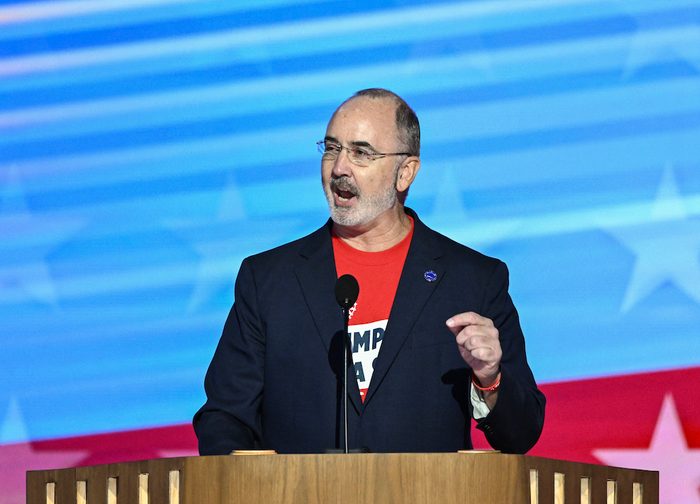
While they are at the center of a brewing nationwide fight, Belvidere workers face limbo in their personal lives. Simms, who is 47, has been at the plant since 1999 and is just five years from retirement. But while out of work she’s unable to accumulate credits for her pension, and if she were to retire before her 30-year mark, this benefit would be significantly reduced. So she is forced to wait until there is a job to work. She went into this industry, she says, expecting to do “30 and out.”
This built-in limit is important, she explains, because assembly line work is hard on your body. Most recently, she worked in the chassis department, where she put the big parts of the vehicle model together. “When you’re in a factory building a car every 48 seconds, it takes a toll on your knees, shoulders, everything,” she says. “Some of the guns torque really hard, that’s stress on shoulders, elbows. You’re on your feet most of the day.”
Simms is one of 815 laid-off members of the local receiving health coverage (but not dental) and Supplemental Unemployment Benefit (SUB) pay, which supplements her unemployment benefits so that she’s bringing in roughly 74% of her previous salary at 40 hours a week, not accounting for lost overtime pay, cost of living adjustments or raises. (Under the contract, workers who receive this are technically coded to “temporarily” laid off.) This benefit, secured in the contract, is helpful, she says, but her current job instability — and that of her ex-husband, also a laid-off Stellantis worker — has already impacted their family.
Before the plant idled, her daughter had been looking at colleges as far away as Texas. But instead she decided to go to a community college in nearby Freeport so that she could “take care of” her younger brother, then a sophomore in high school, in the event their parents had to transfer to a different plant.
Asked about workers experiencing instability, Tinson from Stellantis wrote, “we understand that decisions like these are difficult on communities,” but pointed to the SUB pay and health coverage.
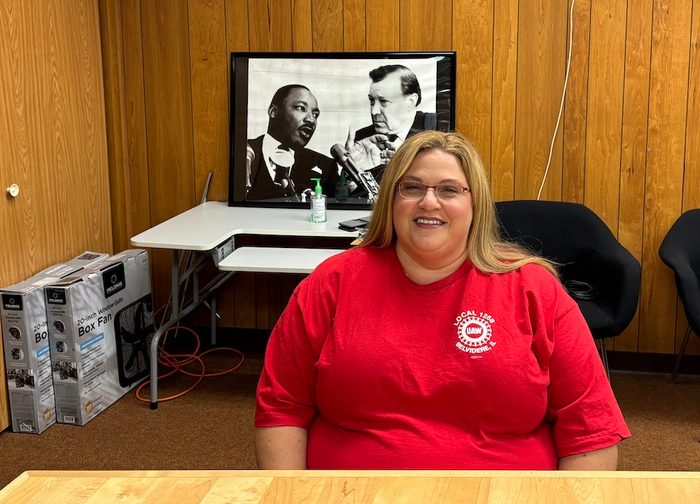
Trina Holmes, 46, who worked at the plant for 25 years before getting laid off, says the company is “obviously out of the loop, because they don’t live our lives daily and aren’t going through what we go through. Carlos just gave himself a 56% raise, so he’s not in touch with the people at all. They haven’t seen what we go through at all, and they obviously have never had to go through something like this.”
Holmes is five years from retirement and has lived in Belvidere her whole life, a town where “everybody knows everybody.” When the plant closed, she thought her world might be uprooted. A single mom, Holmes is active in her church and attends the various sports her teenage son plays, including bowling, golf, shotput and disc. Her fear that she would have to move her son right before his senior year, which “would be hard on any kid,” has not come to pass. Thanks to the SUB pay her union contract won her, she says with relief, “I think he’ll be able to graduate in Belvidere.” Her daughter decided to go to college in Eau Claire, Wisconsin to be near her grandparents, in the event that Holmes would have to relocate after the plant closure.
Sitting in Local 1268’s conference room in front of a framed photograph of Dr. Martin Luther King Jr. and famed former UAW president Walter Reuther, UAW, Holmes tells me that she’s worried not just about herself but about the fate of her hometown.
“If the plant does close, I think it will be devastating to the town,” Holmes says. Workers’ SUB pay is heading off the worst for now, she says, but her friends who are hair stylists or work jobs in the service industry say they’re worried about what will happen “if this plant closes and people move or if we don’t get our SUB pay anymore.”
The workforce has already dwindled significantly. At Local 1268’s height in 2019, it had between 6,500 and 7,000 workers, including employees of suppliers. Around 4,500 of those workers were inside the plant, running three shifts, according to Frantzen.
When the layoffs started, the people working inside the plant went a few different directions: Around 2,300 were either bought off with packages, like buyouts and early retirement, or quit; around 1,500 transferred elsewhere; and there are currently about 945 left who are laid off and receiving SUB pay, including a small portion of workers now represented by UAW Local 1178, due to consolidation. In addition, Frantzen estimates that roughly 80 union workers are at the plant, working parts distribution or maintenance, with distribution workers represented by UAW Local 1178.
Things looked very different for part suppliers who were not direct employees of Stellantis, even though many were in the union. They were ineligible for SUB pay or transfer rights because of how their contracts were written, and so they were cut loose with little to fall back on.
For some, the devastation was immediate — and extreme. Kristin Smith is the director of the B1 Food Pantry in Belvidere, which distributes food every Thursday from a local church. When I met her at the pantry, she explained that her own son worked for a Stellantis supplier before he lost his job, though he has since found new work.
She says that when the plant closed, new faces arrived at the food pantry from the auto industry. The need level is high. When I showed up at 2:30 p.m., they had just run out of food for the day. “Today, we served 526 families, but we could have served 200 more,” Smith says. “The need is bigger than ever.”
Frantzen knows of several laid-off workers who are seeing hard times. “Some are trying to run two households off of one income,” he says. “They’re financially and mentally stressed out there. Some are worse than others.”
For one worker, relocation was followed by tragedy. On August 21, Antonio Gaston, 53, was crushed to death while working at the Toledo, Ohio Jeep complex. He had formerly worked at the Belvidere plant, as a member of Local 1268, and moved to Ohio after getting laid off.
Linda Merrow, the social services director of Belvidere Salvation Army, who provides mortgage and rental help, saw “a big impact” from the closure. People have lost their houses, some have moved out of state, and in some cases kids have been left with other family members, she says. She personally has worked with about 10 families that were made homeless as a result of the plant closure.
“I don’t really have a lot of respect for Stellantis,” says Merrow, who says she is from a “Chrysler family” in Michigan. “They don’t treat their employees right.”
When asked about hardship among laid off workers, and in the broader community, including food insecurity and difficulty with housing, Stellantis spokesperson Tinson just repeated that workers were receiving SUB pay and health coverage.
JC Bengtson, a millwright now out of work at the Belvidere Assembly Plant, says the company’s response “sounds like a corporate, cold-hearted numbers-before-people attitude, and that’s why having a union is so important.”
It is difficult to calculate exactly how far the impact goes. Rosalio Moscato is the owner of a local pizzeria and Italian bakery, Moscato’s, that used to be popular with workers and often made deliveries to the plant. Standing at the register, she says the closure “has not only impacted the city, but all of outside towns,” from nearby Rockford to Winnebago. “That plant is a staple of our community,” she says. Her own morning business has suffered, she explains, but “we have managed to stay afloat.”
Work disruptions are not uncommon in the U.S. auto industry, where hiccups in the supply chains can lead to temporary slow downs. But Belvidere workers are troubled that the lines seem to have fully halted. Those who hung on worry the delays signal an intent to renegotiate the plant’s opening in the 2028 contract — and they fear that their SUB pay could be renegotiated, too.
Bengtson previously lost his job when the Janesville Assembly Plant in Wisconsin closed in 2008. “If they don’t honor their commitment, and they close Belvidere, and the contract expires, what happens to the people here who were counting on that commitment to stay here and be gainfully employed and part of this community?” he asks. “I’m not seeing any transfers being offered. I don’t know if there are any openings at other plants.”
Following the idling of the Belvidere plant, Stellantis started producing the Jeep Cherokee in Toluca, Mexico. And labor journalist Luis Feliz Leon reported in September 2023 that, during contract talks, Stellantis sought to use the threat of sending jobs to Mexico as leverage.
The importance of keeping jobs in America is paramount to Local 1268. The message is echoed in signs and bumper stickers on the walls, and in a mural painted on the side of the building
But Simms, who serves on the union-label committee of her local, which promotes union-made and made-in America products, expresses no animosity toward Mexican workers. “When vehicles get made in Mexico, those workers get a portion of pay less than ours, but prices don’t go down,” says Simms. “I’m all for better wages. That’s what the union is about. I don’t think our jobs should have went to Mexico while we’re sitting here idle. I believe there’s enough work for everybody. I do want jobs to come back to Belvidere, but I don’t want them to come at the cost of someone losing their job.”
Under its current leadership, UAW is making an effort to build solidarity with Mexican workers. In February, the union announced that it would start providing direct, material support to Mexican auto workers trying to build independent unions, as part of a Mexico solidarity project. “The auto industry is not nationally bound, and neither should the labor movement be,” Brandon Mancilla, the elected UAW Region 9A Director, wrote in a Labor Notes article explaining the initiative. “For every record contract there will come the threat of moving production to Mexico, where a partnership between the companies and the corrupt company unions keep wages low — a whipsaw that oppresses workers on both sides of the border.” Mexican auto workers, for their part, have shown solidarity with their U.S. counterparts during GM’s 2019 strike, with some fired in retaliation for refusing to work overtime in solidarity with U.S. workers.
Mancilla writes, “Mexico didn’t ‘take our jobs.’ The Big Three automakers set up in Mexico to exploit cheap labor. Now Mexican auto workers make one-tenth of U.S. workers wages.” Speaking over the phone, Mancilla puts the blame for the Belvidere closure squarely on “corporate greed and free trade policies.” He says, “These companies have no interests other than maximizing as much profit as possible, and not caring about Mexican workers and U.S. workers.”
Murray says that one way the union could be successful is by increasing the costs of draining jobs from Belvidere, which could work in tandem with raising wages in Mexico by “tying larger strikes to this demand” or “increasing the reputational cost.” There is reason to think a strike could be costly: In a July 25 earnings call, Stellantis’ chief financial officer acknowledged that UAW’s stand-up strike hurt the company’s profits.
And then there’s the question of Belvidere production for the electric vehicle sector. The Department of Energy recently announced that Stellantis has moved to the next phase for a $335 million grant to convert the Belvidere Assembly Plant to an electrification plant. This comes even as Stellantis has dragged its feet on its commitments and remained mum about the specific product it plans to manufacture. Frantzen says the union has never seen any drawings or blueprints for what the product will be.
The construction of a unionized EV plant is in line with the UAW’s broader goal to ensure a just transition, in which any shift away from fossil fuels brings good union jobs. In the stand-up strike, UAW won an agreement that workers at electric vehicle plants where the Big Three have joint ventures will be included in the UAW master agreement.
Amid this swirl of factors, Belvidere workers are mobilizing, even as they recognize the greatest power to change their conditions lies elsewhere. “What could Belvidere accomplish by a strike right now? There’s no product to stop,” Bengtson says. “That’s why it’s important to have all those locals involved, to actually have leverage. It’s a good feeling to have these other locals supporting us in that fashion.”
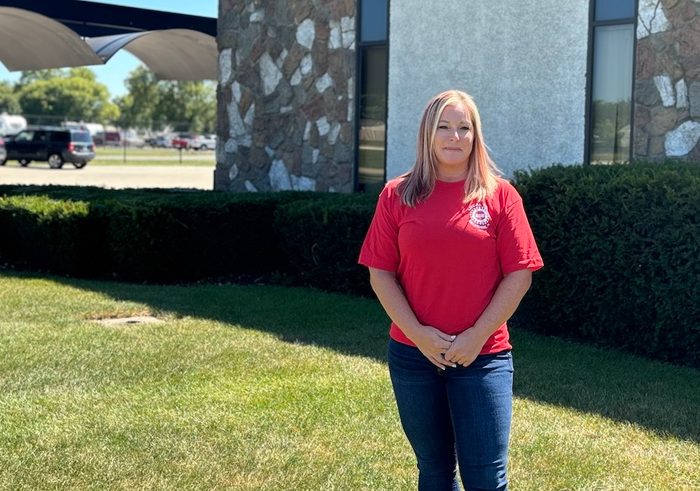
In the meantime, workers have their lives to live. When I interviewed Bengtson in January, he was wary but hopeful. Now that hope has diminished, but it’s still there. When he was laid off, he says, his wife put his lunchbucket in the closet. She has since taken it back out. “She was trying to create some back-to-work-energy. It’s now in the usual spot.”
Simms says that since she’s been out of work, “There’s good days and bad days. I’m involved as much as I can with the union. I spend time being a mom, my favorite, most important job.” Her son plays offensive lineman for his high school football team, and she enjoys the excitement of Friday night lights. He recently started his senior year, and went to his “last first day of school,” she says. “I’m just trying to live in the moment.”
Simms went into this job expecting that it would have a clear end date. “My grandpa retired in ‘92, and he was just broken down, ready to retire. My dad worked 31 years and retired. And I was thinking 30 years,” she says. “I am mad. It isn’t fair. We have sacrificed so much for this company. And here we are, chasing our pensions.”
For now she remains in limbo, “temporarily” unemployed and perpetually five years from retirement. “How long,” she asks, “will it take to get five more years?”
This article is a joint publication of In These Times and Workday Magazine, a non-profit newsroom devoted to holding the powerful accountable through the perspective of workers.
Sarah Lazare is the editor of Workday Magazine and a contributing editor for In These Times. She tweets at @sarahlazare.
